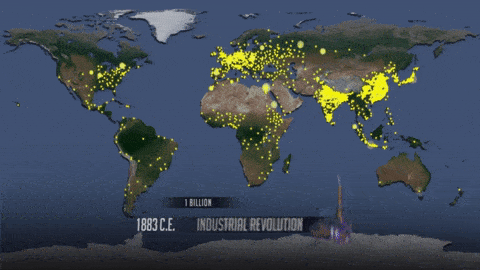Some 2,000 years ago, there were only 170 million people in the whole planet. Most were concentrated around the Italian Peninsula and Central Europe, the Indian subcontinent and south-east Asia. In the Americas, only a couple million people were alive during this time. Fast-forward today, and we can find 7 billion people with only a couple areas like the Sahara, the Arctic , the Amazon basin or Australia’s wasteland spared from our expansion. In between this time, the rate of growth was more or less constant with a couple of ups and downs, following periods of prosperity or, oppositely, great misery (wars, black plague etc.). It wasn’t until the industrial revolution sparked the motors of progress that things really took off.
In only 100 years, population skyrocket from 1 billion to 7. By 2050, it is expected to reach 9.7 billion. This great video shows how this growth took place, all tuned to the soundtrack of a heart beating. Each yellow dot represents one million people concentrated in an area.
The world already consumes 1.5 Earths each year (more resources than can be regenerated), and as population increases the stress will become higher. Not even WWIII would stop a furious growth that will see 10 billion people living on this planet by 2100. Though in some parts of the world growth will stabilize or even follow a negative curve (Europe), some have a potential for a rapid growth like Africa where half of the population growth is expected to happen. Can the world sustain 10 billion people? Not if they live like the wealthiest 1 billion today. We’ll need to eat less meat or none at all, exclusively use renewable energy, cut waste and use smart farming practices. Then, the world might even sustain 20 billion. We just need to tune to the planet’s beat. What it can provide, we’ll accept gladly. But nothing more.
via Vox










